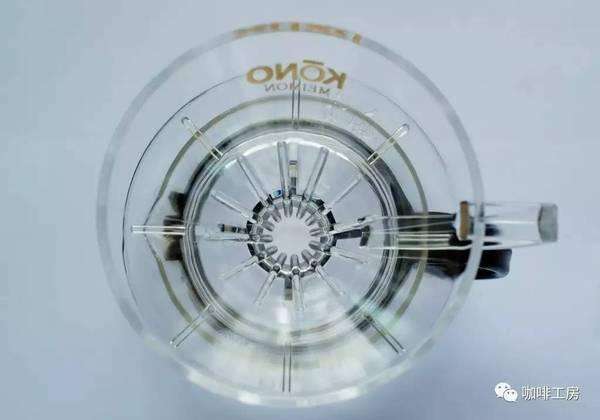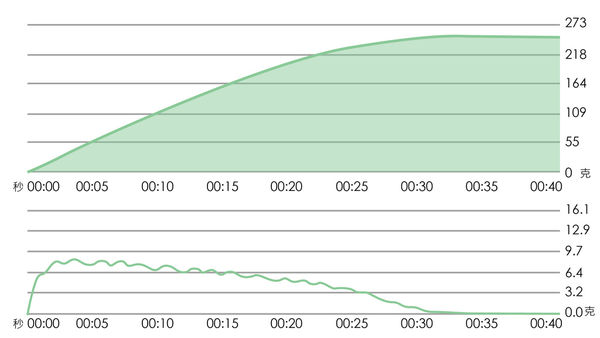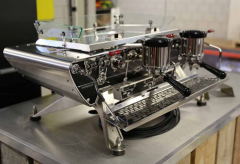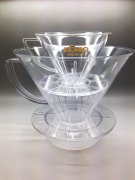Analysis and comparison of the influence of rib design on flow velocity in the 1st, 2nd and 3rd generation of KONO coffee filter cup

Professional coffee knowledge exchange more coffee bean information please follow the coffee workshop (Wechat official account cafe_style)
Hand coffee filter cup is very knowledgeable! Flow rate data of several common coffee filter cups
My impression is that in the summer of 2013, I accidentally opened a magazine called "filter cups" in the side of a friend. One page talked about the comparison of the differences between different filter cups. Because the content is in Japanese, I don't know much about it.
Until 2014, I read an article published by Uncle Coffee about hand-made coffee filter cup. The devil hides in the flow. It was only after that that I realized the main purpose of this article, and there was a truth after the actual experiment.
Therefore, I followed the coffee uncle's experiment to further analyze the effect of the inner ribs of the filter cup on the flow rate.
The main purpose of this experiment is to analyze and compare the influence of the overall flow velocity on the rib design of the third generation of KONO.
The parameters of the experiment are the same except for the filter cup.
Water: RO reverse osmosis water at room temperature
TDS:0.03ppm
Water volume: 250g
Filter paper: KONO MD-25 1x2 human bleached filter paper
Intelligent scale: ACAIA
Experimental method:
1. Put the lower seat on the intelligent scale, and the upper seat (filter cup) on the hand frame, which is separated from the lower seat.
two。 Fold the filter paper and put it on the filter cup and pour 250 grams of water into the filter cup covered with the filter paper at one time.

The condition that the filter cup fits with the filter paper after the Kono generation is drained. Let's take a look at the change in velocity:

From the picture above, the velocity curve of the total water accumulation in the upper way; the pressure curve is at the bottom.
According to the situation in the picture, at about 7 seconds, the pressure begins to drop, indicating that the flow rate is faster, while the water level falls right to the position of the ribs, and the time to completely drain is about 37 seconds.

On the icon, after the second generation of Kono is drained, the filter cup is attached to the filter paper. Let's take a look at the change in velocity:

According to the situation in the picture, like the first generation, the pressure begins to drop at about 7 seconds, and the time to drain completely is about 37 seconds.

On the icon, after the third generation of Kono is drained, the filter cup fits with the filter paper. Let's take a look at the change in velocity:

According to the situation in the picture, it is obviously different from that of the first and second generations. the pressure does not change obviously until 25 seconds, and the time of complete drain is about 35 seconds. It can be seen that the shortening and shallower ribs have a very obvious effect on the flow velocity.
Let me make a comparative analysis of the overlap of the velocity curves of the first to third generations:

Above, blue is the first generation, red is the second generation, and green is the third generation.
It can be seen that the situation of the first and second generation is very similar, but the flow rate of the third generation is much slower. The preliminary reason should be that the shape of the rib is obviously different from that of the first and second generation.
After that, we will open an article to analyze the flow velocity of other conical filter cups, and we should be able to determine more clearly what the influencing factors are.
.
Important Notice :
前街咖啡 FrontStreet Coffee has moved to new addredd:
FrontStreet Coffee Address: 315,Donghua East Road,GuangZhou
Tel:020 38364473
- Prev

Evaluation and introduction of NZ6002 Spirit Duette double-hole Commercial Italian Coffee Machine
Spirit's most advanced multi-boiler espresso machine. Continuous perfect brewing of espresso as the demand, and has excellent ergonomic maneuverability. It is a machine with high precision, large capacity and high efficiency. Spirit's design is based on a central goal, that is, no matter what you give him, he can be accurately presented in the cup. Continued Speedster
- Next

Kono filter cup the most special model-giant version! KONO series 10 people hand coffee filter cup
Professional coffee knowledge exchange More coffee bean information Please pay attention to coffee workshop (Weixin Official Accounts cafe_style) Hand brewed coffee filter cup knowledge! Flow rate data of several common coffee filter cups Players who like to make coffee by hand should be familiar with this gold stamped KONO filter cup, which is a classic design developed by KANO KANO CO., LTD. in 1973
Related
- What is the Philharmonic pressure? How to use Philharmonic pressure to make delicious coffee
- Why does a hand grinder have more fine powder than an electric grinder?
- In addition to the hot mom, what is the difference between the versions of EK43 | ditting and Mahdi ek43?
- What kind of equipment do you need to make coffee by hand? Introduction to novice starter cooking equipment tools
- Espresso needs to be ground how thick and thin scale entry Italian Coffee Machine Bean Grinder investigation and Grinding course
- How much does it cost to open a small private cafe? How much does it cost to learn coffee? How to operate it?
- The difference between the flavor characteristics of hand-brewed coffee and coffee maker is hand-brewed coffee really better than coffee maker? Can I use a coffee machine to make coffee beans by hand?
- The difference between 01 and 02 of hario v60 filter cup what is the difference between 01 and 02 filter cup opening and cooking flavor
- What's the difference between the smart cup and the French kettle? Which is better, the French kettle or the Smart Cup?
- What's the difference between a smart cup and a V60 filter cup? The difference between the taste of smart cup and hand-brewed coffee

